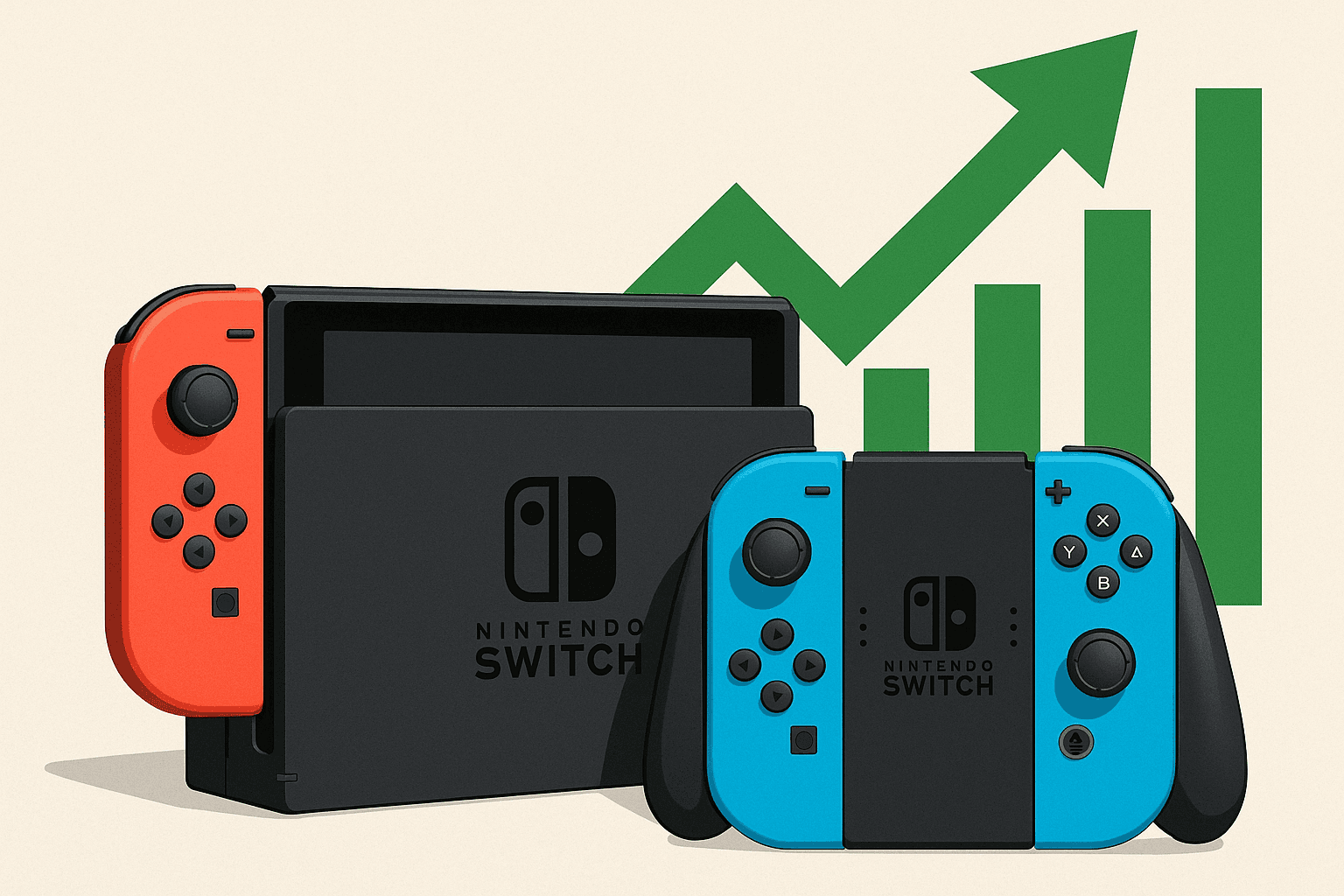Nintendo raises Switch 2 forecast as sales surge past 10 million units

News Summary
Nintendo reported a net profit surge of 270% year-on-year to ¥102.9 billion for the quarter ending September 30, significantly exceeding analyst forecasts. The Switch 2 console has sold 10.36 million units since its June launch, prompting the company to raise its fiscal year sales forecast to March 2026 from 15 million to 19 million units. Revenue reached ¥527.2 billion, also surpassing market expectations. Strong demand for the Switch 2 has propelled the company's shares up nearly 40% this year. Software sales remained robust, with 11.95 million units sold in the quarter, driven by new titles such as Pokémon Legends: Z-A, Mario Kart World, and Donkey Kong Bonanza. To meet sustained demand, Nintendo has requested its manufacturing partners to produce up to 25 million Switch 2 units by March 2026. Despite a higher retail price of approximately $450, its hybrid design, backward compatibility, and strong launch lineup have ensured strong demand in Japan and the US.
Background
Nintendo is a leading global video game company renowned for its innovative hardware platforms and iconic franchises such as Mario, Pokémon, and The Legend of Zelda. Its predecessor, the original Switch, launched in 2017, achieved widespread popularity for its unique hybrid gaming experience, transitioning between a home console and a portable device, leading to sustained sales success and a robust ecosystem. New console launches are a critical component of Nintendo's growth strategy, typically driving significant boosts in both hardware and software sales. However, such launches also present challenges in production, supply chain management, and intense market competition from major rivals like Sony's PlayStation and Microsoft's Xbox. The current global economic environment, including ongoing inflationary pressures and shifts in consumer discretionary spending, poses a backdrop for non-essential goods markets, including gaming. Nintendo faced pressure to ensure sufficient supply and maintain consumer interest with the Switch 2's introduction.
In-Depth AI Insights
Beyond immediate success, what core strategic shifts is Nintendo making to sustain its growth trajectory in a potentially softening global consumer market? - Ecosystem Longevity Strategy: Nintendo is actively replicating the original Switch's success by focusing on building a long-term, engaging Switch 2 ecosystem through continuous flagship IP releases and bundled offers, rather than relying solely on initial hardware sales momentum. - Aggressive Production Scaling: The company's increased production target of 25 million units by March 2026 demonstrates strong conviction in market demand and aims to prevent a repeat of past launch shortages, ensuring wide availability during the critical holiday season. - Confident Pricing Strategy: Despite global economic uncertainties, the Switch 2's launch at a higher price point of $450 indicates Nintendo's confidence in its value proposition, brand loyalty, and the strong appeal of its differentiated hybrid model. - Deep Utilization of First-Party IP: Through new titles like Pokémon Legends: Z-A and continuous updates for classics like Mario Kart World, Nintendo is maximizing the value of its exclusive intellectual properties to drive both software sales and hardware adoption. Considering Nintendo's history and the current market, what are the primary risks to this optimistic outlook, and how might they impact investor sentiment? - Global Consumer Spending Trends: While initial performance is strong, persistent global economic pressures like inflation and potential recession risks could squeeze consumer discretionary spending on non-essential items, potentially dampening long-term demand for the Switch 2. - Supply Chain Resilience Challenges: Despite Nintendo's ramp-up in production, the fragility of global supply chains remains. Any new disruptions could lead to production delays and shortages, hurting sales and consumer confidence, especially during the critical holiday period. - Intensifying Competition: Rival platforms from Sony and Microsoft may introduce new hardware iterations or exclusive titles in their respective ecosystems, potentially diverting market attention and challenging the Switch 2's market share. - Content Release Cadence: Heavy reliance on a few blockbuster IPs carries risks. If future key game releases fail to meet expectations or if there are significant gaps between major launches, it could lead to decreased user engagement and a slowdown in hardware sales. How does Nintendo's current strategy, particularly its pricing and production decisions, position it against competitors in the broader entertainment and gaming sector? - Differentiated Market Niche: The Switch 2's hybrid design sets it apart from Sony and Microsoft's purely high-performance consoles, as well as mobile gaming. Nintendo continues to focus on a unique blend of home and portable experiences, rather than direct competition on graphical prowess. - Competing on Value, Not Price: The higher pricing strategy indicates that Nintendo is competing through its unique innovation, IP appeal, and ecosystem value, rather than engaging in price wars. This helps maintain higher profit margins and reinforces its premium brand image. - Aggressive Market Penetration: By significantly increasing production targets, Nintendo aims to quickly capture market share, especially during the crucial holiday sales season, thereby solidifying its position as a market leader and maximizing network effects. - Content-Driven Longevity: The strategy of focusing on first-party exclusive content and extended product lifecycles allows Nintendo to build a loyal user base, reduce reliance on third-party support, and maintain a competitive edge in the long run.